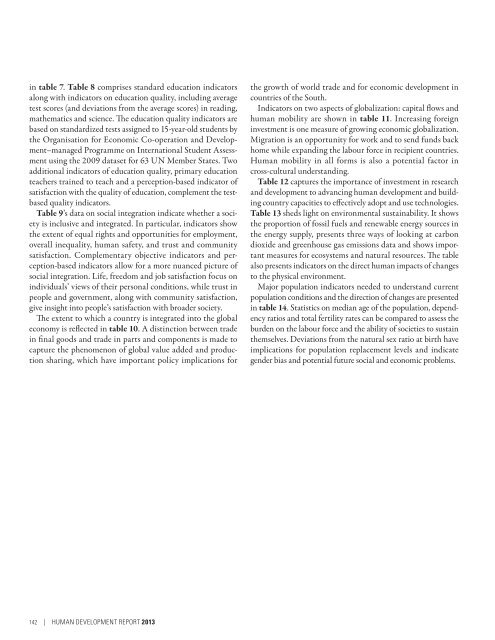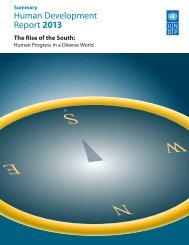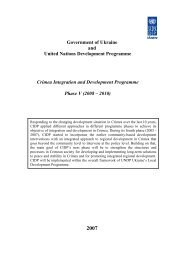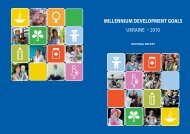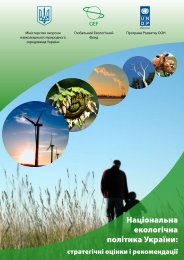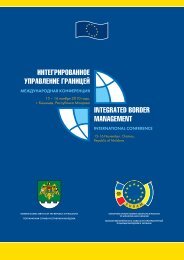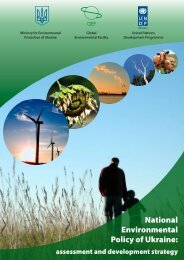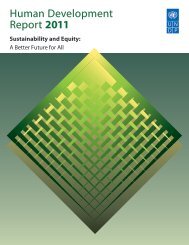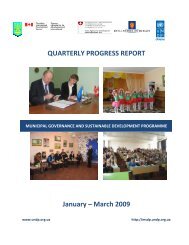E N S W - United Nations Development Programme
E N S W - United Nations Development Programme
E N S W - United Nations Development Programme
You also want an ePaper? Increase the reach of your titles
YUMPU automatically turns print PDFs into web optimized ePapers that Google loves.
in table 7. Table 8 comprises standard education indicators<br />
along with indicators on education quality, including average<br />
test scores (and deviations from the average scores) in reading,<br />
mathematics and science. The education quality indicators are<br />
based on standardized tests assigned to 15-year-old students by<br />
the Organisation for Economic Co-operation and <strong>Development</strong>–managed<br />
<strong>Programme</strong> on International Student Assessment<br />
using the 2009 dataset for 63 UN Member States. Two<br />
additional indicators of education quality, primary education<br />
teachers trained to teach and a perception-based indicator of<br />
satisfaction with the quality of education, complement the testbased<br />
quality indicators.<br />
Table 9’s data on social integration indicate whether a society<br />
is inclusive and integrated. In particular, indicators show<br />
the extent of equal rights and opportunities for employment,<br />
overall inequality, human safety, and trust and community<br />
satisfaction. Complementary objective indicators and perception-based<br />
indicators allow for a more nuanced picture of<br />
social integration. Life, freedom and job satisfaction focus on<br />
individuals’ views of their personal conditions, while trust in<br />
people and government, along with community satisfaction,<br />
give insight into people’s satisfaction with broader society.<br />
The extent to which a country is integrated into the global<br />
economy is reflected in table 10. A distinction between trade<br />
in final goods and trade in parts and components is made to<br />
capture the phenomenon of global value added and production<br />
sharing, which have important policy implications for<br />
the growth of world trade and for economic development in<br />
countries of the South.<br />
Indicators on two aspects of globalization: capital flows and<br />
human mobility are shown in table 11. Increasing foreign<br />
investment is one measure of growing economic globalization.<br />
Migration is an opportunity for work and to send funds back<br />
home while expanding the labour force in recipient countries.<br />
Human mobility in all forms is also a potential factor in<br />
cross-cultural understanding.<br />
Table 12 captures the importance of investment in research<br />
and development to advancing human development and building<br />
country capacities to effectively adopt and use technologies.<br />
Table 13 sheds light on environmental sustainability. It shows<br />
the proportion of fossil fuels and renewable energy sources in<br />
the energy supply, presents three ways of looking at carbon<br />
dioxide and greenhouse gas emissions data and shows important<br />
measures for ecosystems and natural resources. The table<br />
also presents indicators on the direct human impacts of changes<br />
to the physical environment.<br />
Major population indicators needed to understand current<br />
population conditions and the direction of changes are presented<br />
in table 14. Statistics on median age of the population, dependency<br />
ratios and total fertility rates can be compared to assess the<br />
burden on the labour force and the ability of societies to sustain<br />
themselves. Deviations from the natural sex ratio at birth have<br />
implications for population replacement levels and indicate<br />
gender bias and potential future social and economic problems.<br />
142 | Human <strong>Development</strong> Report 2013


